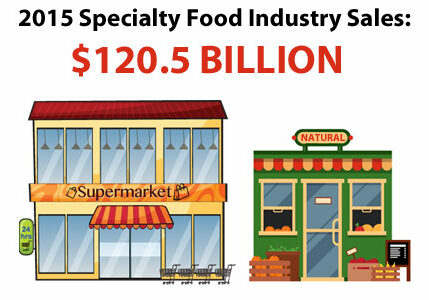Recent News
Natural food stores edging out mass retailers in specialty food sales


The big box now has a big competitor in the specialty food industry. While mainstream retailers account for the largest share of specialty food sales, natural and specialty food stores are growing at an almost equal rate, according to the Specialty Food Association’s (S.F.A.) “State of the Specialty Food Industry 2016” report.
Sales in the specialty food industry hit a record high in 2015, raking in $120.5 billion. The sales gain largely has been fueled by the growth of small businesses, the report said, and sales potential may be biggest in natural stores.
Produced in conjunction with Mintel International and SPINS/IRI, the S.F.A. report tracks U.S. sales of specialty foods through supermarkets, natural food stores and specialty food retailers.
Specialty food sales at retail jumped nearly 20% since 2013 to $94 billion, driven by product innovation and wider availability of specialty foods in the mass market. In the food service segment, specialty food sales increased 27% to $26.5 billion, the report said.
Cheese and cheese alternatives topped the list of top sellers in the category, growing 15% in the past two years. Frozen and refrigerated meat, poultry and seafood snatched the No. 2 spot with an increase of 23%, and chips, pretzels and snacks came in third with a 22% gain. Prepared meals and refrigerated entrees inched into the top 10 after the category’s sales skyrocketed 35% in two years.
Unit sales of specialty foods grew 14% overall to 15.6 billion, led by growth of refrigerated ready-to-drink tea and coffee, which swelled a staggering 302%. Other categories that experienced notable sales growth were eggs, jerky and meat snacks, refrigerated pasta and water.
While 58 out of 61 specialty food categories enjoyed double-digit sales growth in 2015, 15 categories experienced a downturn. The biggest drops were in frozen juices and beverages, drink mixes and concentrates, and ready-to-eat cereals.
As the topic of G.M.O. labeling pushes further into the spotlight, many in the supply chain said they think non-G.M.O. will be a product claim of growing importance to consumers. In fact, 49% of manufacturers plan to introduce non-G.M.O. products in 2016, the report said. Local products continue to gain in popularity as well.
“American consumers continue to move toward specialty foods and away from mass,” said Ron Tanner, vice-president of philanthropy, government and industry relations for the S.F.A. “Consumers are looking for foods with fewer and cleaner ingredients, and products that are made by companies with values they care about. All of these define specialty food.”
Rebekah Schouten
www.foodbusinessnews.net
Check out our latest video
Exploring our target industries
At Davalyn, our tenured team of niche-focused talent acquisition experts takes on the hiring challenges of a diverse and growing set of industries. Make our perspectives your most powerful recruitment and retention resource.

